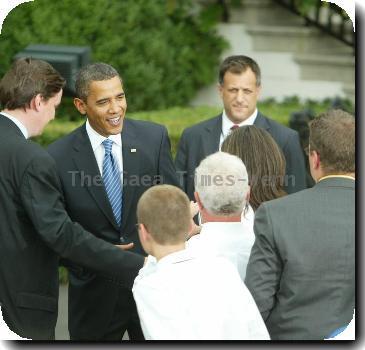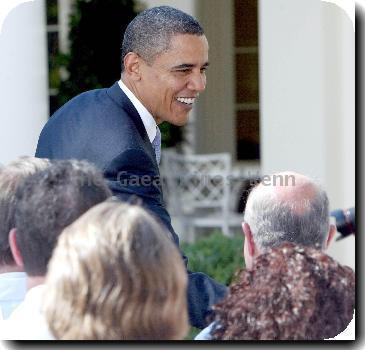Obama welcomes hybrid, electric car battery program funded by federal stimulus
By Ken Thomas, APMonday, September 13, 2010
Obama hails production of stimulus-aided batteries
WASHINGTON — President Barack Obama celebrated the opening of an advanced battery plant in Michigan on Monday as a critical boost for hybrid and electric cars — and a success for his administration’s economic stimulus program.
But even as mass-produced advanced batteries start rolling off assembly lines, costs are high for consumers, and hurdles remain.
“This is about the birth of an entire new industry in America, an industry that’s going to be central to the next generation of cars,” Obama said Monday in a phone call broadcast at the opening of A123 Systems Inc.’s lithium ion battery plant in Livonia, Mich.
“And it’s going to allow us to start exporting those cars, making them comfortable, convenient, and affordable. …. When folks lift up their hoods on the cars of the future, I want them to see engines and batteries that are stamped: ‘Made in America,’” Obama said, according to a transcript of the call released by the White House.
Fending off criticism of the $814 billion stimulus program, the administration has cited the battery industry as one of the success stories. With new facilities coming online in the Midwest, battery manufacturers for the advanced vehicles are providing a test case for the government’s attempt to revive the economy.
About 300 workers, many formerly laid-off auto workers, listened Monday as Obama spoke. Energy Secretary Steven Chu, Michigan Gov. Jennifer Granholm and others were also on hand to promote their production of battery cells and components. Watertown, Mass.-based A123 Systems Inc. received $249 million under the stimulus program and plans to open a second facility next year in Romulus, Mich.
Automotive supplier Johnson Controls Inc. last week started shipping batteries that were made at a Holland, Mich., facility built with the help of $299 million in federal grants. The factory expects to employ 90 workers by late next year and could produce 75,000 to 150,000 batteries a year, depending on the mix of hybrid and electric vehicles it supplies.
The Energy Department estimates that the 48 advanced battery and electric drive projects announced last year under the $2.4 billion program could lead to the production of about 75,000 batteries by next year and 500,000 batteries annually by 2014. Michigan, Indiana, Ohio and South Carolina are the states with the largest share of the projects.
Despite the fanfare, the battery industry faces many hurdles. Gas-electric hybrid vehicles represent about 1 percent of new vehicle sales, and many plug-in hybrids and battery electric cars are just entering the market.
Costs are high. The government has estimated that a battery with a 100-mile range costs about $33,000, although stimulus money could bring that down to $10,000 by the end of 2015.
The federal money has raised questions about whether the projects could create more capacity to build the electric batteries than will be met with demand for the vehicles in the future.
Mary Ann Wright, a Johnson Controls vice president, said if all of the battery companies follow through on plans to build up the industry, it could create more capacity than is needed in the short term. But she said the administration was working to address that by creating tax policies to encourage consumers to buy the vehicles and directing government fleets to adopt the technology.
“The rapid buildup of production capacity by companies with limited experience for product with challenging market may prove wasteful,” said Menahem Anderman, founder and president of Total Battery Consulting, a California-based battery consulting firm.
Anderman said by e-mail that if by 2013-14 the factories are profitable and running at full capacity, Obama officials will be able to claim success. “Unfortunately that scenario is pretty unlikely,” he said.
Matthew Rogers, an Energy Department senior adviser who has overseen the battery grants, said the administration was “very confident” that the demand for the vehicles — both for typical consumers and commercial fleet customers — will keep the factories operating. “The prices of these batteries are coming down faster than we expected,” he said.
The companies say the federal incentives played a major role in opening the plants in the United States. Without the money, they would have turned to Asia, where the vast majority of electronic batteries and components are now built.
“This money was instrumental in the decision to put manufacturing in North America. We think that without this, it’s very unlikely that plants of this size and nature would have been happening in the U.S.,” said David Vieau, A123 Systems’ chief executive.
With unemployment levels close to 10 percent across the nation and higher elsewhere, state governments say the battery program could create a transformative industry that could pay dividends for years.
Granholm, D-Mich., whose state has been ravaged by the economic downturn, said the federal battery program, along with state incentives, is projected to create 63,000 jobs in Michigan. Having the “entire battery ecosystem” will help her state compete for more work as electric vehicles take root.
“This is not the end-all and be-all. This is one slice of the stimulus that has worked and will work — not just for temporary jobs but for permanent, long-term jobs that takes our automotive industry and our mobility in a new direction,” Granholm said.
__
Associated Press writer Erica Werner contributed to this report.
Online:
A123: www.a123systems.com/
Johnson Controls Inc.: www.johnsoncontrols.com
Energy Department: tinyurl.com/3xunnp6
Tags: Automotive Technology, Barack Obama, Energy, Government Programs, Green Technology, Green Vehicle Technology, Michigan, North America, Personnel, United States, Utilities, Washington

